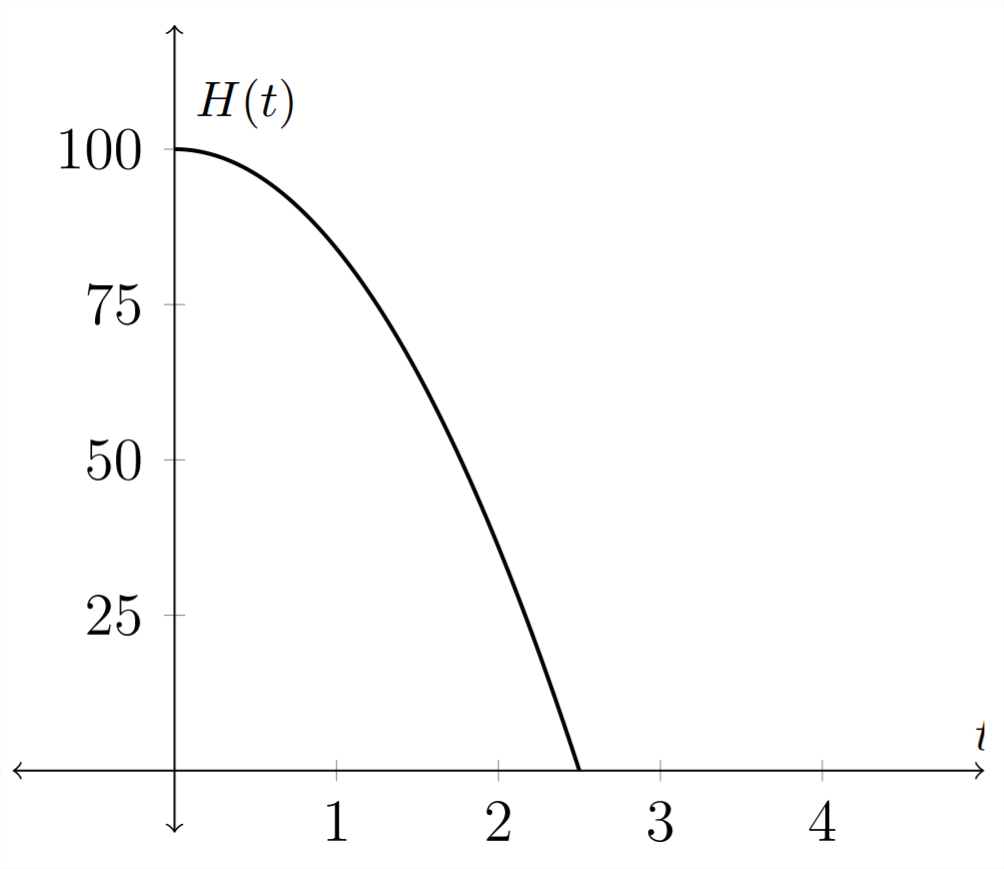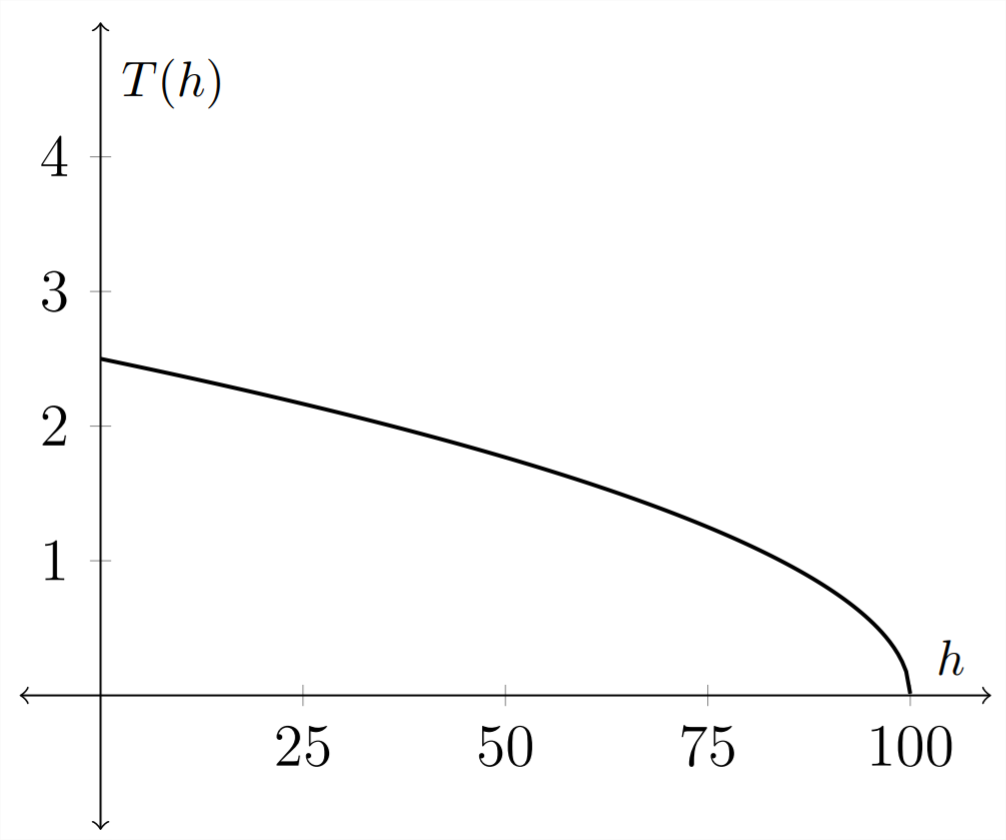4.8: Inverse Functions
( \newcommand{\kernel}{\mathrm{null}\,}\)
An inverse function undoes the action of the original function. So the inverse of a function that squared a number would be a function that square rooted a number. In general, an inverse function will take a y value from the original function and return the x value that produced it.
We can see this in an application. Given an object with little or no air resistance that is dropped from 100 \mathrm{ft}, the function that describes its height as a function of time would be:
H(t)=100-16 t^{2}
In this function, H(t) is the height of the object at time t . If we wanted to turn this around so that it described the time for a given height, then we would want to isolate the t variable. In this example, the graph of the function would change in that the original independent variable - t, becomes the dependent variable in the inverse function.
\begin{aligned}
h &=100-16 t^{2} \\
16 t^{2} &=100-h \\
t^{2} &=\frac{100-h}{16} \\
t &=\sqrt{\frac{100-h}{16}} \\
T(h) &=\frac{\sqrt{100-h}}{4}
\end{aligned}
Original function: H(t)=100-16 t^{2}

Inverse function: T(h)=\frac{\sqrt{100-h}}{4}

Notice that the graph of the function inverse is the original function reflected over the line y=x, because an inverse function interchanges the independent and dependent variables.
Finding a formula for an inverse function can be more confusing when we consider a standard function y=f(x) . In our standard notation, x is always considered to be the independent variable and y is always considered to be the dependent variable.
Notice in the example above that when we graphed the function and its inverse, the label on the x axis changed from t to h . In a standard function, the x axis will always be the x axis and the y axis will always be the y axis. To compensate for this, when we find a function inverse for a function stated in terms of x and y we generally interchange the x and y terms so that x remains the independent variable.
In our example, we had
H(t)=100-16 t^{2}
and found the inverse to be
T(h)=\frac{\sqrt{100-h}}{4}
If the original function had been stated in terms of x and y, then the process would have looked like this:
\begin{aligned}
f(x) &=100-16 x^{2} \\
y &=100-16 x^{2} \\
16 x^{2} &=100-y \\
x^{2} &=\frac{100-y}{16} \\
x &=\sqrt{\frac{100-y}{16}} \\
x &=\frac{\sqrt{100-y}}{4}
\end{aligned}
Then we switch the x and y variables to keep the x as the independent variable:
y=f^{-1}(x)=\frac{\sqrt{100-x}}{4}
\mathrm{So}
f(x)=100-16 x^{2}
and
f^{-1}(x)=\frac{\sqrt{100-x}}{4}
Exercises 4.8
Given the function f(x), find the inverse function f^{-1}(x)
1) \quad f(x)=3 x
2) \quad f(x)=-4 x
3) \quad f(x)=4 x+2
4) \quad f(x)=1-3 x
5) \quad f(x)=x^{3}-1
6) \quad f(x)=x^{3}+1
7) \quad f(x)=x^{2}+4 (x \geq 4)
8) \quad f(x)=x^{2}+9 (x \geq 9)
9) \quad f(x)=\frac{4}{x}
10) \quad f(x)=-\frac{3}{x}
11) \quad f(x)=\frac{1}{x-2}
12) \quad f(x)=\frac{4}{x+2}
13) \quad f(x)=\frac{2}{x+3}
14) \quad f(x)=\frac{4}{2-x}
15) \quad f(x)=\frac{3 x}{x+2}
16) \quad f(x)=-\frac{2 x}{x-1}
17) \quad f(x)=\frac{2 x}{3 x-1}
18) \quad f(x)=-\frac{3 x+1}{x}
19) \quad f(x)=\frac{3 x+4}{2 x-3}
20) \quad f(x)=\frac{2 x-3}{x+4}
21) \quad f(x)=\frac{2 x+3}{x+2}
22) \quad f(x)=-\frac{3 x+4}{x-2}
Find the inverse function for each of the following applications.
23) The volume of water left in a 1000 gallon tank that drains in 40 minutes is modeled by the equation:
V(t)=1000\left(1-\frac{t}{40}\right)^{2}
Find T(v) - the function that tells you how long the water has been draining given a particular volume left in the tank. Time is measured in minutes and the volume is measured in gallons.
24) The speed of a vehicle in miles per hour that leaves skid marks d feet long is modeled by the equation:
R(d)=2 \sqrt{5 d}
Find D(r) - the function that tells you the stopping distance for a vehicle traveling r miles per hour.
25) The period of a pendulum of length \ell can be expressed by the relationship:
T(\ell)=2 \pi \sqrt{\frac{\ell}{980}}
Find the function L(t) that determines the length of a pendulum given its period. Here the time is measured in seconds and the length is measured in centimeters.
26) The volume of a sphere of radius r is given by the formula:
V(r)=\frac{4}{3} \pi r^{3}
Find R(v) - the function that determines the radius of a sphere given its volume.

